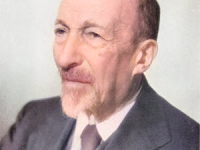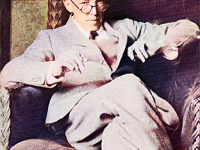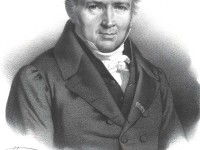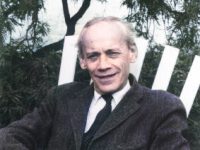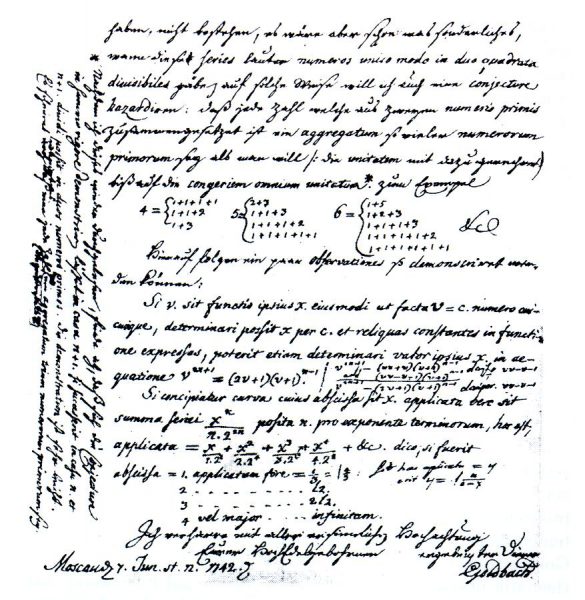
Letter by Goldbach to Leonard Euler dated June 7, 1742
On the 7th of June 1742, Prussian mathematician Christian Goldbach wrote a letter to his famous colleague Leonard Euler, which should make history. Well, at least in the mathematical world. In this letter Christian Goldbach refined an already previously stated conjecture from number theory concerning primes to his friend Euler, which by today is known as the famous Goldbach conjecture. It states:
Every even integer greater than 2 can be expressed as the sum of two primes.
And still today it holds…
And still today this conjecture holds, but could never be formally proven. Even Leonard Euler himself was not able to give a proof. By the end of june he replied in a letter to Goldbach:
“Dass … ein jeder numerus par eine summa duorum primorum sey, halte ich für ein ganz gewisses theorema, ungeachtet ich dasselbe necht demonstriren kann.” (“every even integer is a sum of two primes. I regard this as a completely certain theorem, although I cannot prove it.”)
Slow Progress on the Problem
Progress has been made on this problem, but slowly – it may be quite awhile before the work is complete. All attempts to solve the problem remained unsuccessful for a long time. G.H. Hardy and J.E. Littlewood in 1923 succeeded in showing that if certain theorems concerning Dirichlet L-functions (which have not been proved till now) are valid, then any sufficiently large odd number is the sum of three prime numbers.[3,5] Vinogradov in 1937 showed that every sufficiently large odd integer can be written as the sum of at most three primes, and so every sufficiently large integer is the sum of at most four primes.[4] One result of Vinogradov’s work is that we know Goldbach’s theorem holds for almost all even integers. In 1973 Chen Jing-run proved that every sufficiently large even number is a sum of a prime and a number composed of at most two primes.[3] Some years ago, Jean-Marc Deshouillers, Yannick Saouter, and Herman te Riele have verified Goldbach’s conjecture with brute force computing with the help of a Cray C90 super computer up to 1014. And on April 4, 2012 Thomás Oliveira e Silva has finished a distributed computer search that has extended over years and has verified the conjecture for up to 4*1018.
The Life of Christian Goldbach
Born the son of a Protestant pastor, Christian Goldbach studied medicine and law at the Albertus University in his home town Königsberg, Prussia (today’s Kaliningrad, Russia) . From 1710-1724 he went on longer study trips through Germany, England, the Netherlands, Italy and France. He came into contact with many well-known mathematicians such as Gottfried Wilhelm Leibniz, Leonhard Euler, Nicolas I. Bernoulli and acquired thorough mathematical knowledge. Back in Königsberg he met Georg Bernhard Bilfinger and Jakob Hermann. Both had been appointed by Tsar Peter the Great to the newly founded St. Petersburg Academy. Goldbach then applied to the President of the Academy Lorenz Blumentrost (1692-1755) in July 1725 and was appointed professor of mathematics and history. At the constitutive first meeting on 27 December 1725 he acted as secretary of the Academy. In 1727 Goldbach was appointed teacher to the young Tsar Peter II and moved with him to Moscow. From 1727 onwards, regular academic correspondence began with Leonhard Euler, who had been appointed to the Petersburg Academy, which lasted for several decades.
Later Life
After the death of Peter II from smallpox in 1730, the entire court moved again from Moscow to St. Petersburg with the new Tsarina Anna. Goldbach followed and resumed his activities at the Academy. In 1737, together with Johann Daniel Schumacher (1690-1761), he was appointed managing director of the academy. Despite the unstable and changeable political conditions in tsarist Russia, Goldbach managed to remain in the favor of the powerful throughout. In the 1740s he discontinued his activities at the Academy and took up a well-paid position in the Russian Foreign Ministry. Later he was commissioned to draw up principles for the education of princes of royal blossom.
David Eisenbach, Goldbach Conjecture – Numberphile, [10]
Further Reading:
- [1] Apostolos K. Doxiadis: Uncle Petros and Goldbach’s Conjecture: A Novel of Mathematical Obsession, Bloomsberry (2001)
- [2] Goldbach’s original letter to Euler
- [3] Hazewinkel, Michiel, ed. (2001) [1994], “Goldbach problem“, Encyclopedia of Mathematics
- [4] Ivan Matveevich Vinogradov and the Goldbach Conjecture, SciHi Blog
- [5] G. H. Hardy and the aesthetics of Mathematics, SciHi blog
- [6] Euler’s Correspondence with Christian Goldbach
- [7] Christian Goldbach at zbMATH
- [8] O’Connor, John J.; Robertson, Edmund F., “Christian Goldbach“, MacTutor History of Mathematics archive, University of St Andrews.
- [9] Christian Goldbach at Wikidata
- [10] David Eisenbach, Goldbach Conjecture – Numberphile, Numberphile @ youtube
- [11] Deshouillers, J.-M.; Effinger, G.; te Riele, H.; Zinoviev, D. (1997). “A complete Vinogradov 3-primes theorem under the Riemann hypothesis”. Electronic Research Announcements of the American Mathematical Society. 3 (15): 99–104.
- [12] Timeline of early Number Theorists, born before 1900, via DBpedia and Wikidata

